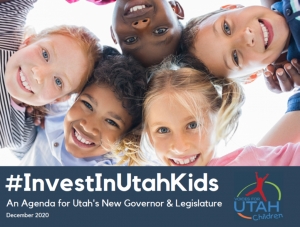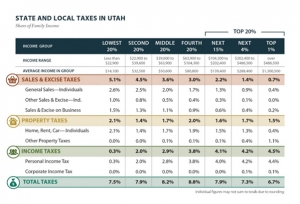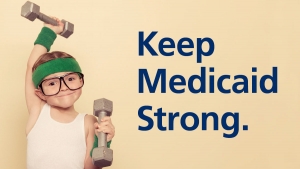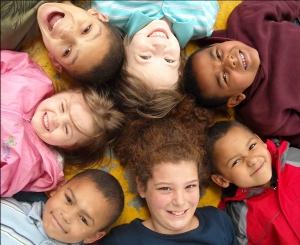Medicaid
#InvestInUtahKids: An Agenda for Utah's New Governor and Legislature
Salt Lake City - Voices for Utah Children released publicly today (January 6, 2021) "#InvestInUtahKids: An Agenda for Utah's New Governor and Legislature," the first major publication of our new #InvestInUtahKids initiative.
Utah begins a new era in this first week of January, with the swearing in of a new Governor and Lt. Governor and a new Legislature. The arrival of 2021 marks the first time in over a decade that the state has seen this kind of leadership transition. Last month Voices for Utah Children began sharing with the Governor-elect and his transition teams the new publication, and on Wednesday morning Voices will share it with the public as well.
The new publication raises concerns about the growing gaps among Utah's different racial, ethnic, and economic groups and lays out the most urgent and effective policies to close those gaps and help all Utah children achieve their full potential in the years to come in five policy areas:
- Early education
- K-12 education
- Healthcare
- Juvenile justice
- Immigrant family justice
The report, which was initially created in December and distributed to the incoming Governor and his transition teams, closes with a discussion of how to pay for the proposed #InvestInUtahKids policy agenda. The pdf of the report can be downloaded here.
Children’s Health
A Healthy Foundation for All Utah Kids to Thrive
Children and families need access to affordable, quality, health care. Health insurance provides a critical foundation for kids, so they can stay healthy, manage health conditions or problems, perform better in school, be active and thrive. ALL Utah kids should have access to health insurance.
Unfortunately, too many Utah children do not have access to health coverage. Utah has:
- One of the highest rates of uninsured children in the nation, 61,000 children (6%).
- One of the highest rate of uninsured Hispanic/Latino children in the nation.
- One of the highest rate of children currently eligible for health insurance, but not enrolled.
How do we do we reach 100% Coverage and care for Utah kids?
To address these problems, Voices for Utah Children works to strengthen health care access for families. Utah parents are working hard every day to make sure their kids are healthy, we need to make sure our healthcare policies are working for them. We focuses on four pillars of policies to ensure that we reach 100% kids covered in Utah. Additionally, we advocate to protect the integrity of the foundational coverage that CHIP and Medicaid provides by showing the positive impact the programs have on children. Together we can help all kids be healthy and reach their full potential.
Join our 100% Kids Coverage Coalition to ensure all children in Utah have access to coverage and care! Click here to join our campaign today.
- Cover All Kids
- All Year Round Coverage
- Connect Kids To Coverage
- Protect Parent Coverage
Great News!
Cover All Kids 2024 Update:
No child should be denied care, but thousands of children are unable to get health coverage or forced to delay or forgo treatment because they lack coverage. We want to make sure all children can have the coverage and care they need this year. This year, thanks to the passage of SB217: Children's Health Coverage Amendments more immigrant children will qualify for coverage. We are ecstatic to monitor and support the implementation of Utah's new State CHIP Program!
All Year Round Coverage 2024 Update:
Currently, only children on CHIP had access to year round coverage. Lack of year round coverage has meant thousands of Utah children possibly losing their health insurance at some point in the year due to red-tape, administrative error, or changing family circumstances. Thanks to changes from the federal government, all children on Medicaid will have access to year round coverage (12-month continuous eligibility) starting January 2024!
Let’s Keep All Families Covered: New Report Finds Number of Uninsured Latino Children in Utah on the Rise
Let’s Keep All Families Covered: New Report Finds Number of Uninsured Latino Children in Utah on the Rise
2020 Utah Legislature Made Strides to Help All Children Stay Covered
Decades of progress improving health coverage rates for Latino children has begun to erode nationwide, and Utah is seeing significant increases in both the number and rate of children going without insurance, according to a new report by UnidosUS and Georgetown University Center for Children and Families. These findings raise concerns that many children may not be able to access the health care they need during the COVID-19 pandemic.
Utah’s rate of uninsured Latino children rose faster than the national average, a statistically significant increase from 11.1 to 17.3 percent between 2016 and 2018. The number of children increased by about 60 percent, from about 18,900 to more than 30,200. What’s more, Latino children are almost 3½ times as likely to be uninsured as non-Latino children in Utah in 2018, a gap that is greater than the national average.
The report authors point to Trump Administration policies and rhetoric targeting immigrant families, as well as efforts to undermine health care programs, which have made it more difficult for families to sign their eligible children up for public health coverage. These national factors may influence children in Utah and the trend in the wrong direction.
During the 2020 Legislative Session, the Utah Legislature took a significant measure to reverse this trend and improve coverage for all Utah children by appropriating funding to keep children covered, a policy known as Medicaid 12-month continuous eligibility. Continuous eligibility ensures children can maintain stable, year-round health coverage, even if parents experience temporary changes in income or employment status, especially important given the abrupt changes many low-income families are experiencing now.
State Senator Luz Escamilla, champion for 12-month continuous coverage and children’s health care, said: “Health coverage is critical for all children because it improves their health and educational outcomes during childhood and sets them up for a healthier and more prosperous future with better opportunities to reach their full potential.” Said Senator Escamilla, “The actions this session show that working together we can make progress to help Utah kids.”
A policy of continuous coverage is a key priority of the 100% Kids Coverage Campaign, led by Voices for Utah Children, to ensure that all children in the state have health coverage. The campaign also calls for more Medicaid and CHIP outreach and coverage for children regardless of their family immigration status. Report lead author, Kelly Whitener notes, “The majority of uninsured children are eligible for affordable health coverage through Medicaid or CHIP but not enrolled.”
Voices for Utah Children policy analyst, Ciriac Alvarez Valle said, “Going forward, we will work to help more children and families get covered and overcome barriers to enrollment and care.” Alvarez Valle added, “No family should be afraid to get the care they need. We call on our state leaders to help Utah families feel safe getting health care now.”
For help enrolling in health insurance, visit: www.takecareutah.org or call 2-1-1
For the full report: https://ccf.georgetown.edu/2020/03/10/decade-of-success-for-latino-childrens-health-now-in-jeopardy/
###
Fall Kids’ Coverage Roundup… The Halloween Edition
Going Down a Scary Path: Utah kids are losing health insurance
Over the past two years, Utah has seen an alarming increase in our child uninsured rate. After years of steady progress, it is frightening to see kids lose health insurance. 7.4% or 72,000 Utah kids now lack health insurance, when only 6% or 59,000 kids were uninsured in 2016. We are seeing some of the most significant coverage decline among young children, age 0-5, an age when it is so critical for kids to have access to have screenings, check-ups and care. Why is this happening? Over the past two years Utah and our nation have experienced an unpredictable health care environment, affecting CHIP, Medicaid expansion and the ACA, leading to misinformation and confusion; administrative complexity and lack of continuous coverage leading to disruptions in kids coverage; anti-immigrant policies and rhetoric leading families to feel unwelcome and unsafe enrolling in programs. These are scary barriers keeping Utah kids from getting the care and coverage they need and Voices for Utah Children will be working hard to keep Utah from continuing down this path any further.
Tricks and Treats
After a roller coaster summer, the Utah Department of Health is submitting a waiver proposal to expand Medicaid, fully, up to 138% of the federal poverty level. Currently, Utah has only partially expanded Medicaid. Partial expansion has meant that more individuals are eliglble for Medicaid, but also that thousands of individuals and parents are still shut out of coverage, while Utah pays more money to cover fewer people. We are excited for Utah to take this step closer to full Medicaid expansion, as voters supported.
But unfortunately, this latest waiver proposal also includes harmful, additional barriers such as work reporting requirements and additional cost requirements for enrollees. These added requirements will make it harder for Utah parents and children to get coverage and care. Comments are needed to prevent these harmful requirements from moving forward.
We need your help to get Utah back on the right track to full expansion (the ‘treat’ without the tricks!). Submit your comments today to stand up for full Medicaid expansion, without additional barriers or restrictions.
Finally, the Public Charge rule was recently blocked in the courts. The Public Charge is postponed until further notice. But we still have work ahead of us and we must undo the damage already done as a result of anticipation of this harmful rule, and other anti-immigrant hostilities.
Learn more about the latest developments in the Public Charge rule here.
Poverty Advocates Tax Reform Letter
Utah Poverty Advocates Call for Fairer Taxes and Restoration of Public Revenues
Salt Lake City - Today (September 26, 2019) at the Utah State Capitol, a group of two dozen non-profit organizations that provide services to and advocate on behalf of Utah's low- and moderate-income population released a letter to the Tax Restructuring and Equalization Task Force. The letter calls on the Task Force to consider the impact on low-income Utahns as they consider tax changes that could, in the worst case scenario, make Utah's tax structure more regressive and less able to generate the revenues needed to make critically important investments in education, public health, infrastructure, poverty prevention, and other foundations of Utah's future prosperity and success.
The text of the letter and the list of signatories appears below (and is accessible as ![]() a pdf at this link):
a pdf at this link):
Open Letter to the Tax Restructuring and Equalization Task Force (TRETF)
Tax Reforms for Low- and Moderate-Income Utahns
September 2019
Dear Senators, Representatives, and Other Members of the TRETF:
We, the undersigned organizations that work with and advocate for low- and moderate-income Utahns, urge you to consider the impact on the most vulnerable Utahns of any tax policy changes that you propose this year.
We urge you to address the two major challenges facing our tax structure as it impacts lower-income Utahns:
1) Utah’s current system of taxation is regressive, in the sense that it requires lower-income Utahns to pay a higher share of their incomes to state and local government than it asks of the highest-income Utahns, even though about 100,000 lower-income Utah households are forced into – or deeper into – poverty by their tax burden every year.

This regressivity could be addressed with tax policy changes including the following:
- A Utah Earned Income Tax Credit (EITC) to allow the working poor to keep more of what they earn.
- Remove the sales tax entirely from food, as 34 other states have done.
- Remove the state income tax on Social Security benefits for low- and moderate-income seniors; Utah is one of only 13 states that tax these benefits.
- Restore the income tax rate to 5% or increase it above that level. (Because the majority of all Utah income is earned by the top quintile of taxpayers, and because the Utah income tax more closely matches Utah’s income distribution than any other tax, most of such an income tax rate increase would be paid by the top-earning 20% of Utahns, while most lower-income Utahns are shielded from income tax rate increases.)
- Disclose and evaluate the effectiveness of tax expenditures (revenue lost to the taxing system because of tax deductions, exemptions, credits, and exclusions); Utah’s lack of transparency in this area of taxation earned us a C grade from the Volcker Alliance, a leading evaluator of state budgetary practices founded by former Federal Reserve chairman Paul Volcker.
2) For decades, Utah’s overall level of taxation relative to the state’s economy has been dropping, as illustrated in the chart below from the Utah State Tax Commission:

The unfortunate result is that we are left with a tax structure that fails to generate sufficient revenues to allow our state and local governmental entities to properly meet their responsibilities and fulfill their appropriate role in a number of critical areas, including the following:
- Education: Utah ranks last nationally for our per-pupil investment in K-12 education. Particular areas of weakness include:
-
- · Teacher turnover rates are higher than the national average. One study found the majority of new teachers leave within seven years.
- · Pre-K: Utah ranks 36th for our percent of lower-income 3- and 4-year-olds attending pre-school, private or public. We are also 1 of only 7 states not to have statewide public preschool programs. (The state offers only small-scale programs in a limited number of local school districts.) Yet we know from multiple research sources that every dollar invested in high-quality day care and preschools produces at least a $7 return on that investment in future years.
- · Kindergarten: Only a third of Utah kids participate in full-day kindergarten, less than half the national average, because local school districts can’t afford to offer it. Voices for Utah Children estimates that it would cost at least $75 million to offer full-day K to all Utah kids (not including potential capital costs).
- · According to the January 2019 report of the Utah Afterschool Network, the need for after-school programs exceeds the supply many times over, leaving tens of thousands of children completely unsupervised, meaning they are less likely to do their homework and more likely to engage in unsafe activities.
In addition to these input measures, Utah is also lagging behind in terms of several significant educational outcome measures:
-
- · Our high school graduation rates are lower than national averages for nearly every racial and ethnic category, including our two largest, Whites and Latinos.
- · Among Millennials (ages 25-34), our percent of college graduates (BA/BS or higher) lags behind national trends overall and among women.
Moreover, Utah is in the midst of a demographic transformation that is enriching our state immeasurably but also resulting in majority-minority gaps at a scale that is unprecedented in our history. For example, in our education system:
-
- · Our gap between White and Latino high school graduation rates is larger than the national gap.
- · Education Week recently reported that Utah ranks in the worst 10 states for our growing educational achievement gap between haves and have-nots.
- · We are beginning to see concentrations of minority poverty that threaten to give rise to the type of segregation and socio-economic isolation that are common in other parts of the country but that Utah has largely avoided until now.
B. Infrastructure: Utah’s investment has fallen behind by billions of dollars. This is another area where the Volcker Alliance ranked Utah in the worst nine states for failing to track and disclose to the public the dollar value of deferred infrastructure replacement costs. In addition. Internet infrastructure is lacking in some rural counties, limiting their integration into Utah’s fast-growing economy.
C. Mental Health and Drug Treatment: Utah was recently ranked last in the nation for our inability to meet the mental health needs of our communities, according to a recent report from the Kem C. Gardner Policy Institute. Underfunding of drug treatment and mental health services costs taxpayers more in the long run as prison recidivism rates rise because the needed services are not available. Estimates are that Utah meets only 15% of the need for these vital, life-saving services.
D. Affordable housing units fall 41,266 units short of meeting the need for the 64,797 households earning less than $24,600, yet the annual $2.2 million state allocation to the Olene Walker Housing Loan Fund has not changed in over two decades, despite inflation of over 60%. Among extremely low-income renter households, 71% pay more than 50% of their income for housing, which is considered a severe housing burden. This year, the Olene Walker Housing Loan Fund used up most of its annual $14 million budget at its very first meeting of the fiscal year (made up of both state and federal funds).
E. Health care: Our rates of uninsured children are higher than national averages – and rising – especially among the one-in-six of our children who are Latino. In Utah 35,000 or 5% of White children are uninsured (national rank = 36th place), compared to 31,000 or 18% of Latino children (rank = 46th = last place in 2017).
F. Disability services: The 2018 annual report from the Utah Department of Human Services’ Division of Services for People with Disabilities reports that the wait list for disability services grew to a record level of 3,000 individuals last year and that the average time on the wait list is 5.7 years.
G. Seniors: The official poverty measure undercounts senior poverty because it does not consider the impact of out-of-pocket medical expenses. A 2018 study found that seniors spent $5,503 per person on out-of-pocket medical expenses in 2013, making up 41% of their Social Security income. (For most seniors, Social Security is the majority of their income, and it makes up 90% or more of income for 21% of married couples and about 45% of unmarried seniors.)
H. Domestic Violence: Although Utah's overall homicide rate is significantly lower than the national average, domestic-violence-related homicides constitute over 40% of Utah's adult homicides compared to 30% nationally. Several thousand women continue to be turned away annually from crisis shelters because of lack of capacity. Additional state funding would make it possible to substantially increase the capacity of overburdened crisis shelters. We are one of the few states without domestic violence services in every county.
Given the large number of urgent needs that are not being met because of our chronic shortage of public revenues, we are concerned that Utah is missing the opportunity to make critically important upfront investments now that would allow us to reap substantial rewards in the future, and that our most vulnerable neighbors will pay the greatest price as a result.
Thus, we urge you to consider the ways that the state tax structure impacts single parents, disabled adults, low-income children, seniors on fixed incomes, and other vulnerable population groups as you decide on your tax restructuring and equalization proposals.
Finally, thank you for all the time and effort you are personally investing as volunteer members of this important Task Force, and for all that you do for our state through this and other forms of public service.
Yours truly,
|
American Academy of Pediatrics Utah Chap. Catholic Diocese of Salt Lake City Coalition of Religious Communities Community Action Program of Utah Community Development Finance Alliance Community Rebuild |
Comunidades Unidas Crossroads Urban Center Epicenter First Step House League of Women Voters Utah Legislative Coalition for People with Disabilities ICAST Habitat for Humanity of Southwest Utah |
Moab Area Hsg Task Force Provo Housing Authority RESULTS Utah Rocky Mountain CRC Self-Help Homes, Provo, UT Utah Citizens’ Counsel Utah Coalition of Manufactured Homeowners Utah Community Action Utah Food Bank Utah Housing Coalition Utahns Against Hunger Voices for Utah Children |
Time for Full Medicaid Expansion
New reports that the Trump Administration will not grant Utah waivers for a partial Medicaid expansion only underscore what we know: Utah must move forward with full Medicaid expansion, without delays or barriers.
Too many Utahns have been shut out, unable to access health care, because of partial expansion: Families making just above the poverty level; kids, whose coverage is affected by their parents’ coverage; new moms 60 days postpartum; individuals trying to improve their lives. Let's not gamble with Utahns' health care any more; too many Utahns have been kept in limbo and left out of coverage.
It’s time for Utah to stop paying more to cover fewer people and move forward with the full Medicaid expansion Utahns clearly support and need.
July Kids’ Coverage Roundup
Updates on kids coverage in Utah: Kids are losing Medicaid/CHIP coverage, meanwhile Utah is still paying more to cover fewer people…and more!
Why are Utahns paying more to cover fewer people?
Under Utah’s current partial expansion plan (aka the “bridge plan”), Utah is paying 30% more to cover thousands of fewer kids and families on Medicaid. To date, around 34,000 new individuals have enrolled in Medicaid coverage, although at least 50,000 still remain in the gap, unable to afford coverage on their own and not offered it through their job. Utah has left at least $7 million in federal funds on the table so far-- funds that could be used to help more families get coverage and care. (New update: latest reports state the Trump administration will reject Utah's partial expansion. It's time to stop paying more to cover fewer people.)
Alarming Trend in Kids' Medicaid/CHIP Coverage
Utah kids are dis-enrolling from Medicaid/ CHIP at an alarming rate. At the July Utah Medicaid Advisory Committee meeting we learned that over 2,000 kids lost Medicaid/CHIP coverage last month. Such a steep drop cannot be explained by a strong economy alone. The number of Utah kids leaving CHIP/ Medicaid are among the highest in the nation. Both the Utah Department of Health and Department of Workforce Services have committed to doing additional investigation as to WHY kids are losing coverage. We greatly appreciate that they are taking this issue seriously and are working to find answers.
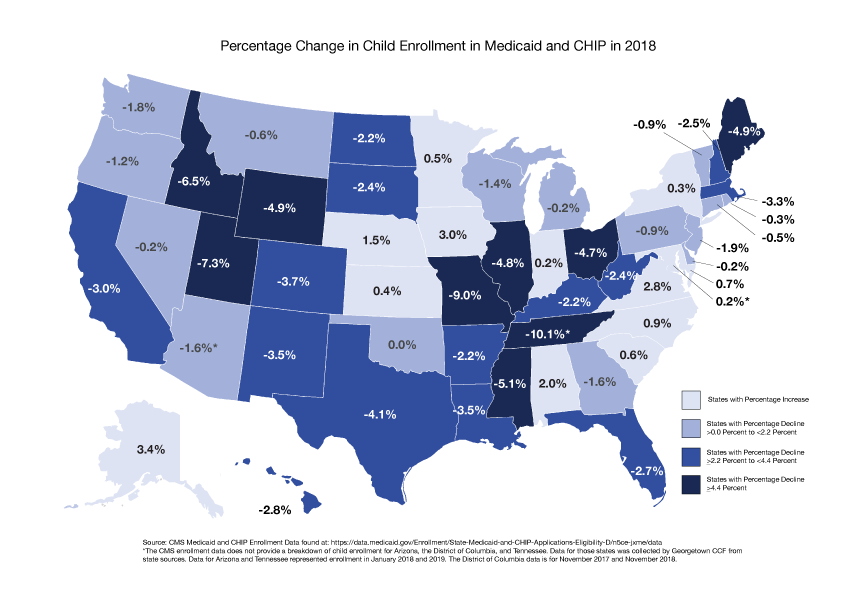
Utah Medicaid Advisory Committee Once Again Prioritizes 12-Month Continuous Eligibility- Let's Keep Kids Covered!
For the third straight year, the Utah Medicaid Advisory Committee prioritized 12-month continuous eligibility for children on Medicaid as one of their top funding requests to the Governor. 12-month continuous eligibility would allow more kids to get covered- and stay covered. Current Medicaid reporting requirements mean many kids unnecessarily lose coverage, with cascading negative impacts. This policy would protect kids and families. The Utah Medicaid Advisory Committee has continually prioritized this as a cost-effective, best practice to keep kids healthy, consistently voting in favor of the Utah Department of Health adopting this policy.

The Latest on Utah’s Medicaid Waiver
Utahns submitted a record 1,700 comments on Utah’s partial Medicaid expansion. Thanks to all who stood up for voter-approved full Medicaid expansion. Utahns voiced strong opposition to the proposed cuts, caps and barriers to Medicaid coverage which would leave many kids and parents without coverage or care. These comments send a message to state and federal officials and will provide the backbone for any future legal action.
Haven’t submitted a comment yet? There’s still time! Submit a comment here: www.utahchildren.org/comment

Voices for Utah Children opposes the state of Utah’s proposal to make harmful changes to the Medicaid program. As part of Senate Bill 96, which rolled back Proposition 3 full Medicaid Expansion, the Utah Department of Health is required to seek a federal waiver to add restrictions and cuts to Medicaid. The “Per Capita Cap” waiver is a dangerous proposal that puts the overall financial stability of the Medicaid program at risk by capping funding and creating new barriers for families seeking care.
This waiver proposal undermines voter-approved full Medicaid expansion; it limits coverage options to a fraction of those who need it; and sets a dangerous precedent for other states looking to deny vulnerable residents affordable coverage options.
It is imperative that Utah instead realize full Medicaid expansion- without caps, cuts or barriers, so Utahns can get the affordable coverage they need to thrive.
The public now has an important opportunity to comment on the waiver proposal. Public comments play a critical role and can make a difference in defeating these proposed harmful changes. Learn more and submit your comments.
###
2019 Utah State of Children's Coverage Report, 100% Kids: Giving All Kids the Opportunity to Thrive
Report: 2019 UTAH STATE OF CHILDREN’S COVERAGE REPORT 100% Kids: Giving All Kids the Opportunity to Thrive
Executive Summary
Health insurance coverage provides children with the foundation they need to be healthy and thrive. When children have health insurance, they have better health outcomes, greater academic success and more economic opportunities later in life.
Utah lags behind the rest of the nation when it comes to covering kids. In Utah, 7% of all children are uninsured, compared to 5% nationally. While Utah has made significant strides over the years connecting more children to coverage, in the last year, Utah’s child uninsured rate has increased. In 2017, Utah was one of only nine states to see its child uninsured rate trend in the wrong direction.
Who are the uninsured children of Utah? They are overwhelmingly low-income. Typically, their parents are uninsured too. The majority are eligible for CHIP or Medicaid insurance, but not enrolled. Some are not eligible for insurance at all because of their citizenship or immigration status. They live across Utah, with a higher percentage of uninsured children living in rural areas. Some children may have never been insured; some may have had insurance and then lost it or had a parent dis-enroll them due to stigma or fear of enrolling in public health insurance programs. They come from all racial and ethnic backgrounds however, a disproportionate percentage of uninsured children in Utah are Latino, the highest in the nation. Some come from families experiencing intergenerational poverty, some are immigrants, refugees or asylum seekers, facing steep obstacles to their health and well-being.
But no matter who they are, they are all Utahns. When 7% of our child population lacks health insurance, we put Utah’s future at risk. Utah is at a unique moment to challenge the negative trends and demand that all children, no matter their background, zip code, citizenship or immigration status, can access affordable health coverage.
The 100% Kids Coverage Campaign is led by a diverse coalition of stakeholders. This multi-year campaign has a goal of ensuring all Utah children will have coverage. Guided by four over-arching policy recommendations, the Campaign proposes to change Utah’s health coverage landscape:
- Strengthen and protect Medicaid coverage for parents
- Keep kids covered all year round
- Support consistent outreach and enrollment support
- Cover all kids, regardless of background or immigration status
Through targeted policies, political and community engagement, we can ensure that all Utah kids have the health coverage they need to grow, thrive and succeed in life. We believe that it is possible for 100% of Utah children to have access to affordable, consistent health coverage. We invite you to join us and help us reach 100% together.
The full report can be downloaded below. For a free print copy please call Voices at 801-364-1182
100% Kids Coverage Campaign & Coalition Launch
100% Kids Coverage Campaign & Coalition Launch
Giving All Kids the Opportunity to Thrive
FOR IMMEDIATE RELEASE
Wednesday, May 22, 2019
CONTACT:
Ciriac Alvarez Valle
801-364-1182
Salt Lake City —A coalition of over 20 diverse stakeholder organizations will announce a campaign aimed at ensuring that all Utah children have health care coverage, regardless of background, geography, immigration status, or income this Friday, May 24that 10 am at the Voices for Utah Children office (details below).
Utah has one of the highest uninsured rates for children in the country. In the last year, Utah was one of only 9 states to see an increase in its child uninsured rate, up from 6% to 7%. Children of color and immigrant children are disproportionately affected, of the 71,000 children without health insurance, almost 43% are Latino children. The Campaign aims to reduce the disparities in coverage and ensure that every child has the ability to access affordable health coverage.
During the launch, Voices for Utah Children will share its new State of Children’s Coverage Report with detailed information regarding Utah coverage, disparities to care and barriers faced by immigrant families. The 100% Kids Coverage Campaign focuses on four main policy priorities: Protecting and fully expanding affordable coverage for parents and pregnant women; keeping kids covered all year round; helping families connect and stay covered; and covering all kids regardless of immigration status. More detailed information about the campaign can be found here: https://utahchildren.org/issues/100-kids-covered.
The report includes several stories and testimonies from immigrant families on the importance of health insurance. “If [our family] had medical insurance, I’d be a calmer woman, with less stress, and more happiness because I’d have my son in his therapies that he really needs,” said one Utah mother in the report.
“Our campaign is committed to ensuring that Utah is a place for all children to grow up healthy, regardless of immigration status,” said Ciriac Alvarez Valle, Health Policy and Community Engagement Fellow for Voices for Utah Children. “We are encouraged to have so many groups come together in support of getting Utah to 100% Kids Coverage.
The Campaign & Coalition Launch will be held on Friday the 24th at 10:00 AM at the Voices for Utah Children Office (747 E South Temple #100).
###

